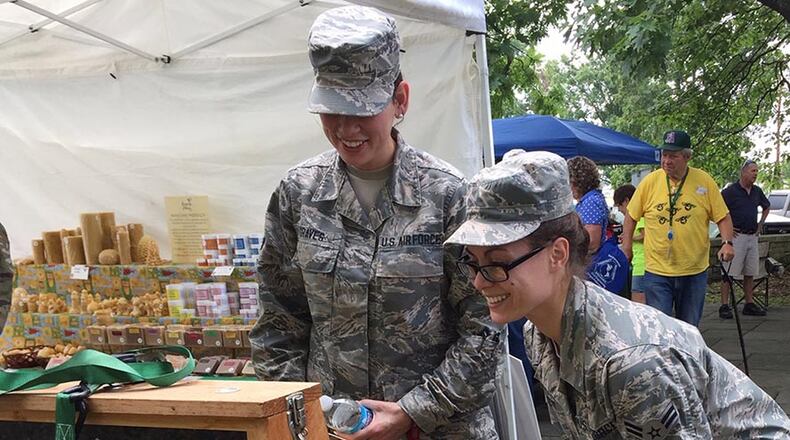The expo was coordinated by personnel in the 88th Civil Engineer Group, Installation Management, Environmental Branch, Assets Section.
The base is a natural fit for the expo as it is the first military installation nationwide to be declared a “Bee City USA,” a designation it achieved in 2017.
Wright-Patterson partners with Propolis Projects, a local non-profit organization committed to re-establishing vigorous populations of pollinators in Ohio. One hundred acres of Huffman Prairie now hosts a quarter million bees of multiple colonies that Propolis Projects maintains.
“Pollinators are important to our food supply, and they are important to the biodiversity of the planet,” said Danielle Trevino, natural resources technician and event coordinator. “The average person should really care about them because we all like food.”
So do pollinators. So planting plants native to Ohio, like milkweed; letting at least parts of lawns and yards include clover and flowers; and avoiding the use of insecticides, fungicides and herbicides are things everyone can do to help pollinators.
Wright-Patt has established seven monarch butterfly waystations that base organizations have adopted and maintain, Trevino said.
“We want to work with organizations and communities to do our part to sustain pollinator populations,” she said.
Holding events like the Pollinator Expo is important, said Barbara Bloetscher, state apiarist with the Ohio Department of Agriculture.
“Events like this create awareness of what we can do to help the bees,” she said.
Varroa mites are seen as the greatest threat to bees in Ohio, but Wright-Patt’s bees, living near the southwest and northeast ends of the flight line, are fighting back, Bloetscher said, by chewing the legs off the mites to lessen their impact.
Bloetscher pronounced the fighters “healthy, sturdy bees.”
Karen Levin, executive director of the Levin Foundation and the Propolis Projects, said the base offers bees “ideal surroundings.”
“Working with the government has been a wonderful experience, and we enjoy doing things that help bees and all pollinators,” Levin said. “You have plentiful food and water here, and those are what bees need to thrive as a colony. We have been very pleased with the outcome.”
Even the Wright brothers were tangentially associated with bee keeping, as their friend Amos Ives Root, an apiarist, was the first to have a published account of the brothers’ first flight at Huffman Prairie in a scientific periodical. Root also published the article in his own magazine, “Gleanings in Bee Culture.”
Attending the expo to learn more about bee culture was David Hall, an Air Force veteran, employee at the Air Force Research Laboratory and third-year beekeeper, who came to talk to other beekeepers and find out which plants bees prefer. He got into beekeeping to produce his own honey to help alleviate his wife’s and daughter’s allergies.
“I’m still a novice. It’s a family project. We are producing enough honey that I can sell some,” Hall said. “Not only am I helping my family’s allergies, which the doctor has noticed, but now I’m into conservation.
“I’ve never heard of another base that does things like this, has actual beehives and is so involved in conservation,” he continued. “It’s phenomenal. It makes you proud to work for the government. Wright-Patt stands out.”
Perusing the booths for bee-related items were four members of the Bioenvironmental Sciences Engineer Squadron, 88th Medical Group.
“We call ourselves the BEES,” said Airman 1st Class Lillian Levy. “We know that bees and other pollinators are truly important for the environment. Our trees, flowers and vegetables are here because of them.”
Also enjoying the expo were Chris and Kim Bigelow and their daughters Natalie and Hannah. Chris Bigelow is the new science teacher at St. Charles Borromeo School in Kettering and as a volunteer helped establish pollinator and student vegetable gardens, producing 700 pounds of food last year alone. The family visited with Elisabeth Rothschild, Ohio lepidopterist volunteer, to learn how caterpillars and moths are pollinators.
Ranger Ryan Qualls from the Dayton Aviation Heritage National Historical Park and the site manager for the Huffman Prairie Interpretive Center, welcomed the visitors and said having the expo at the Wright Memorial is a natural fit.
“We’re talking about things that fly; it’s a neat correlation and it’s a good way to work with Wright-Patterson Air Force Base for what is a very fun, public event,” he said.
In the end, though, the expo was about education.
“Every individual can impact pollinators, be it positively or negatively,” Trevino noted. “We should all be doing our part to ‘plant native’ and reduce our use of herbicides.”
“It’s unnatural to have your lawn look like a golf course,” Levin pointed out. “It should have dandelions, clover and other things in it so bees can feed.”
For additional information on Bee City USA and how to help, go online to beecityusa.org.
About the Author
